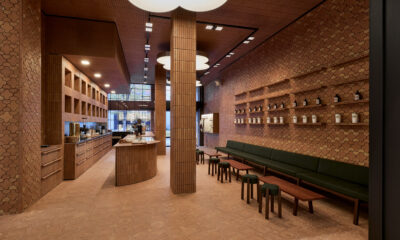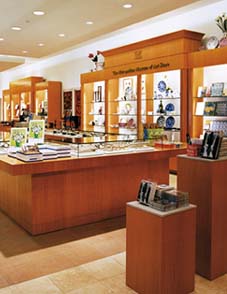Museum stores often violate many of the rules of good retailing: They're too formal, not inviting and scare off customers.
“In trying to emulate the formality of the museum,” says Richard Philipps of the Orion Group (New York), “the stores send out a confusing message about the merchandise, which many customers believe to be original, unaffordable and unattainable.”
In designing the Metropolitan Museum of Art's satellite store in The Mall at Short Hills (N.J.), where the average price point is about $40, Phillips says “our challenge was to put the customer back into the retailing equation. We decided to take the emphasis off 'museum'and put it on 'store.'”
But here's the tricky part. It still is, after all, a museum store. And so the all-important connection between the museum and the shop itself cannot be ignored. Orion bridged that gap with stone. At Short Hills, stone announces the museum shop's presence to passersby – the 130-foot glass storefront is broken by a simple-but-elegant portal of antique-filled travertine. Inside, there are two kinds of stone flooring: Pale beige travertine is used to define the circulation paths, while a darker shade of fired limestone helps to unify the many parts of the store's layout. The cool stone provides a striking contrast to the warm wood veneers. “It evokes a sense of the antique and traditional in an otherwise bright, warm and contemporary interior,” says Philipps.
Although the Short Hills store is the third rollout of a prototype satellite shop concept the Orion Group created for New York's venerable Met (the others are at New York's La Guardia Airport and in Las Vegas), it was the first “where we were able to incorporate all our new ideas into the approach,” Philipps says. To accommodate the 1800-SKU inventory (ranging from art reproductions and jewelry to sculpture, stationery, prints and books) in an open-sell environment, a variety of wall cases, pedestals and tables in honey-colored anigre veneer are used in an inviting arrangement that draws customers through the 2600-square-foot space.
Advertisement
The wall cases, lit from within, circle the perimeter, arranged like furniture in freestanding bays that call attention to individual merchandise categories. All the merchandise is brightly lit “with incandescent spots to hit the individual pieces and compact fluorescents to fill the circulation,” Philipps notes. A fluorescent ceiling cove softly enhances the high level of illumination.
Because most elements of the design prototype were already in place, the Orion Group was able to design and build the Short Hills shop in just five months. The firm has three satellite shops on the boards in the current MMA rollout.
Client Design Team: Metropolitan Museum of Art, New York – David Hopkins, manager, satellite shops store planning and visual merchandising; Kathy Mucciolo, manager, visual merchandising
Design Team: Orion Group Inc., New York – Richard Philipps, principal-in-charge; Wendy Philipps, materials and finishes
General Contractor: National Contractors Inc., Bloomington, Minn.
Architect: Yar Kunycia, Haddon Heights, N.J.
Advertisement
Outside Consultants: Charles Fertig, Staten Island, N.Y. (engineering) Suppliers: Architectural Woodsmiths Inc., Shippensburg, Pa. (millwork); Artisan Graphic Group Ltd., Huntington Station, N.Y. (signage); Architectural Systems Inc., New York (stone flooring); Durkan, Dalton, Ga. (carpeting); Viaggio Inc., Farmington, N.Y. (jewelry buildup fabric); Hamilton Adams, New York (wall case fabric); Benjamin Moore, Montvale, N.J. (paint)
Photography: James D'Addio, Hastings on Hudson, N.Y.


 Headlines1 week ago
Headlines1 week ago
 John Ryan2 weeks ago
John Ryan2 weeks ago
 Headlines7 days ago
Headlines7 days ago
 Headlines2 weeks ago
Headlines2 weeks ago
 Headlines1 week ago
Headlines1 week ago
 Retail Buzz3 days ago
Retail Buzz3 days ago
 Headlines1 week ago
Headlines1 week ago
 Headlines1 week ago
Headlines1 week ago


















